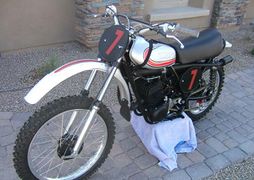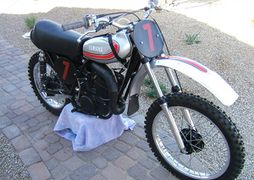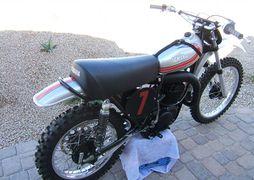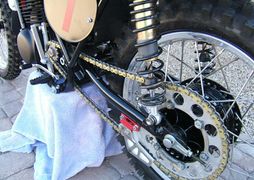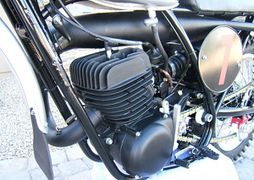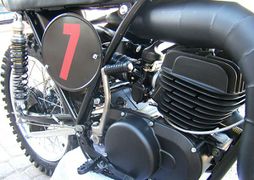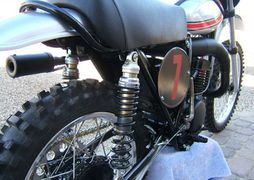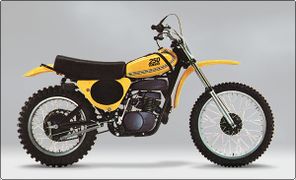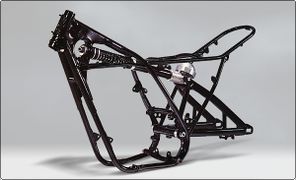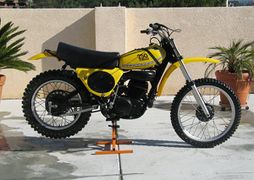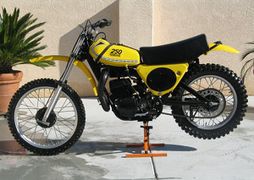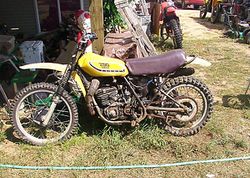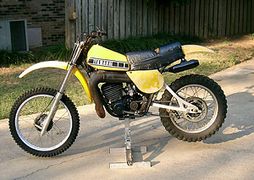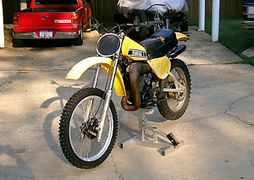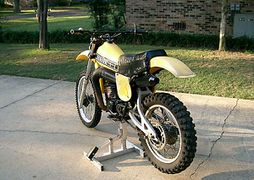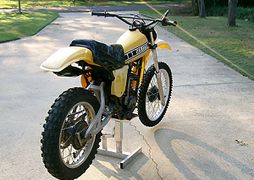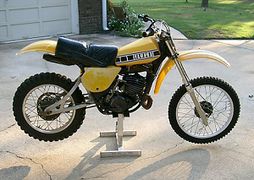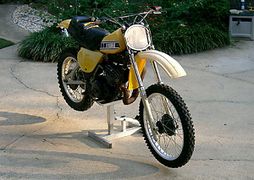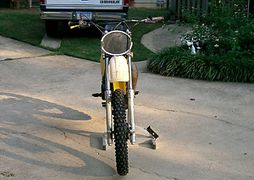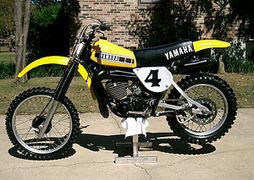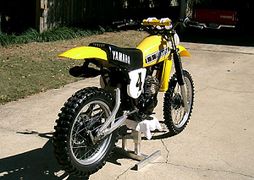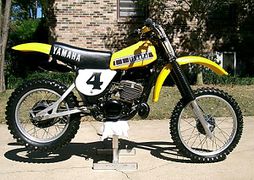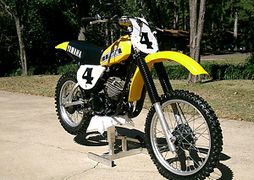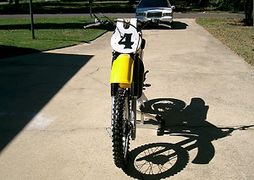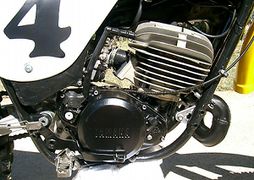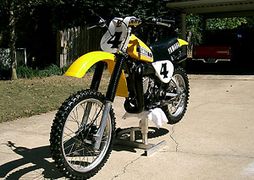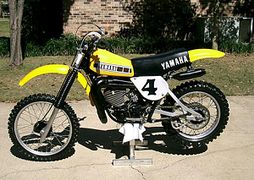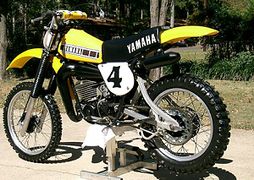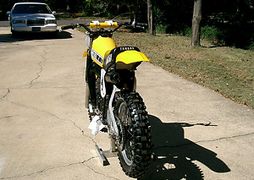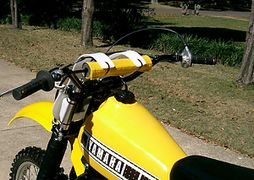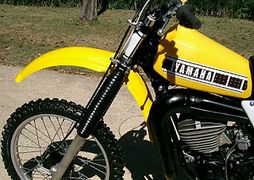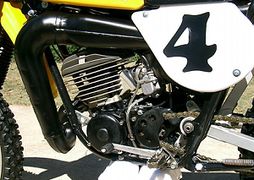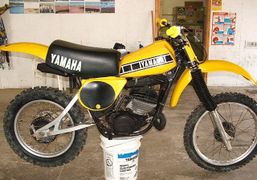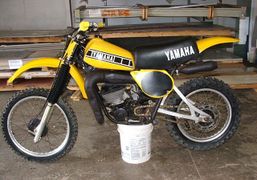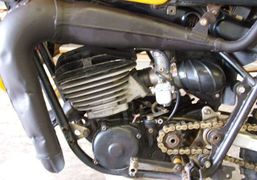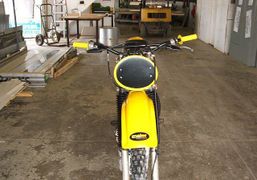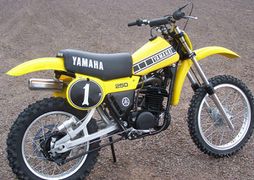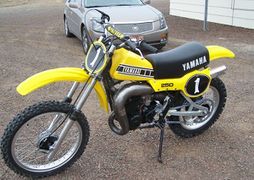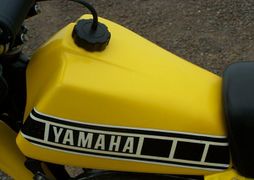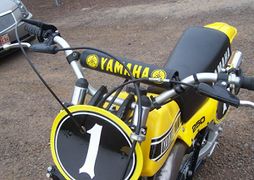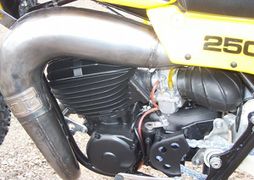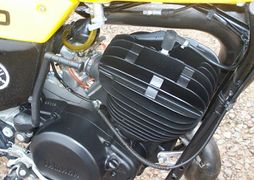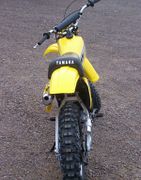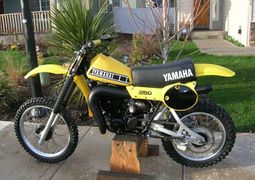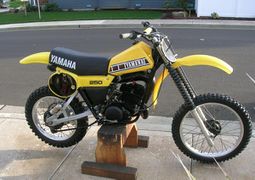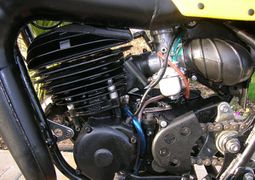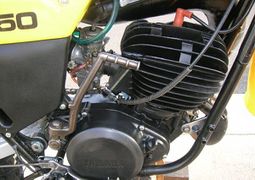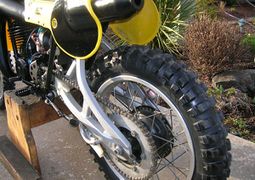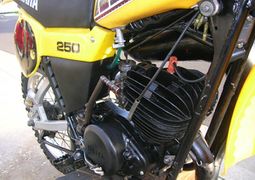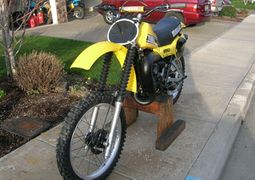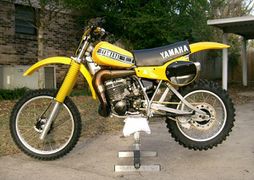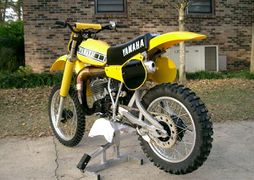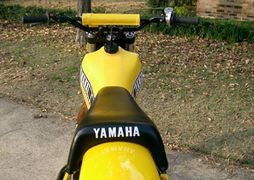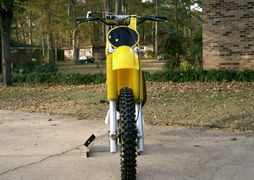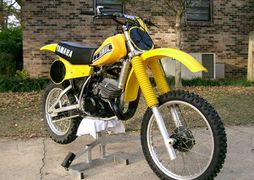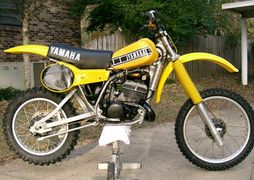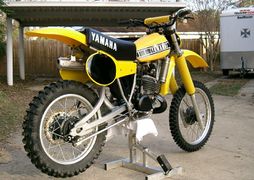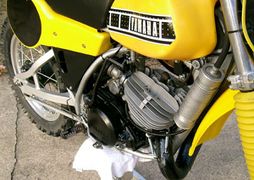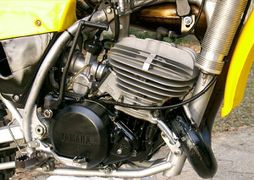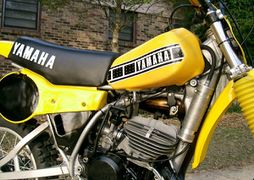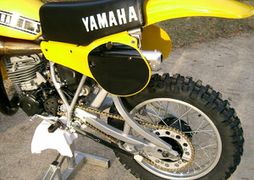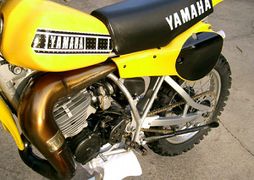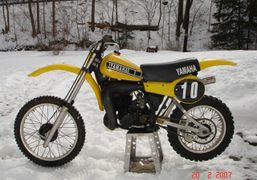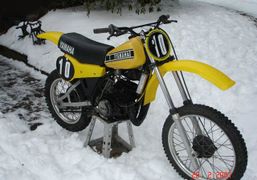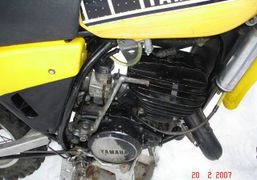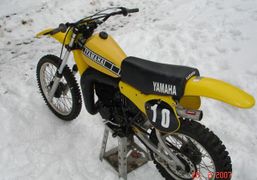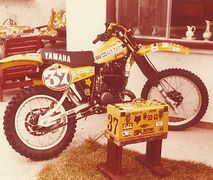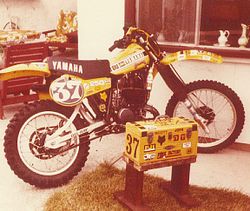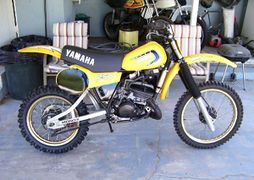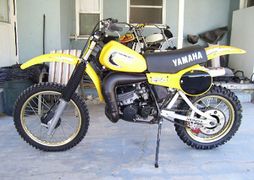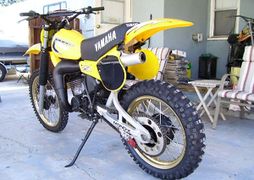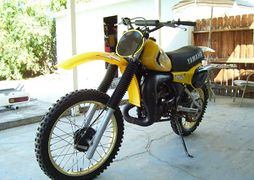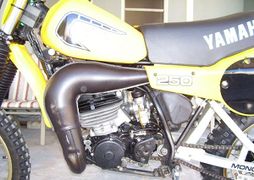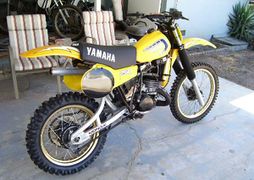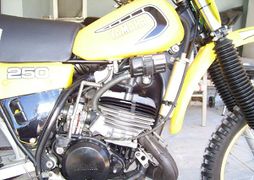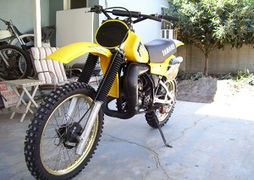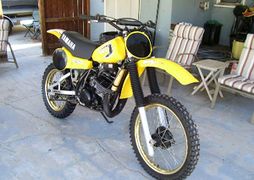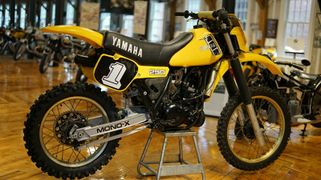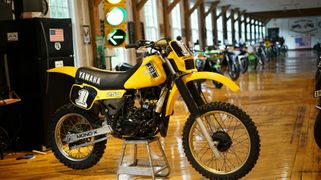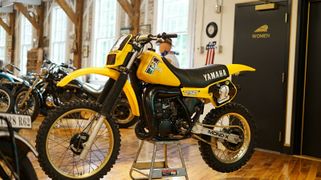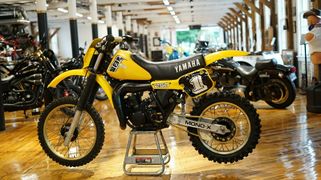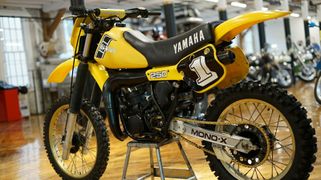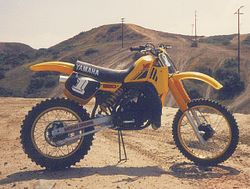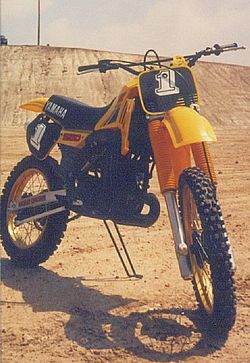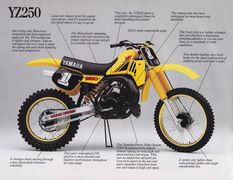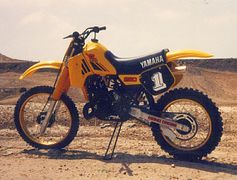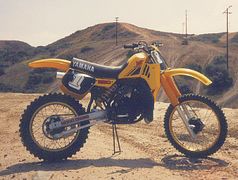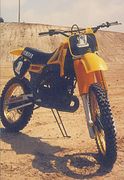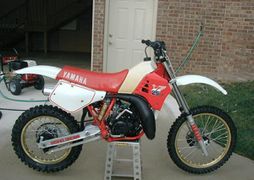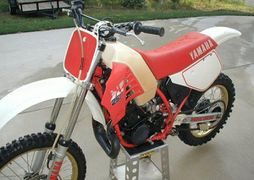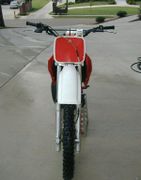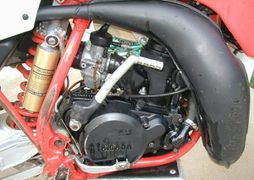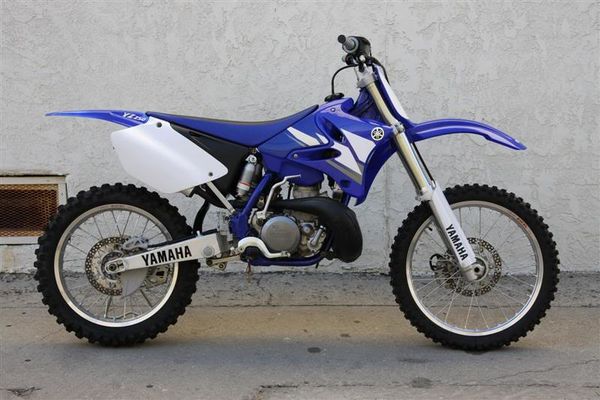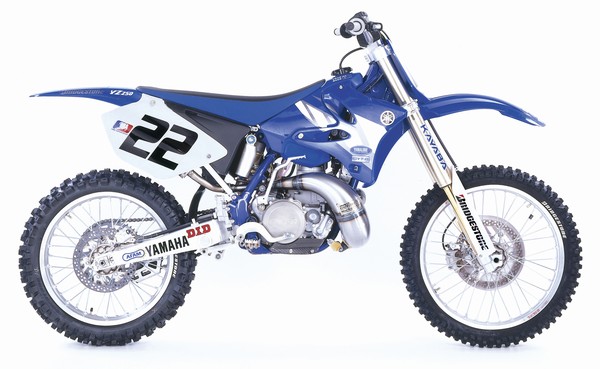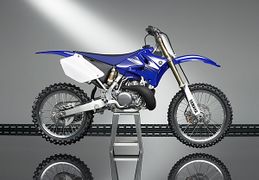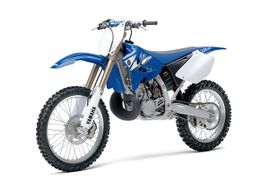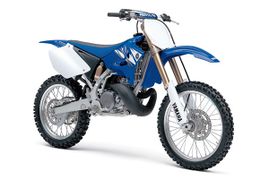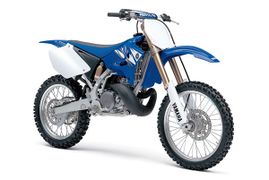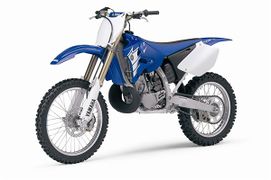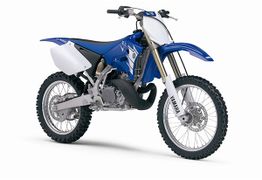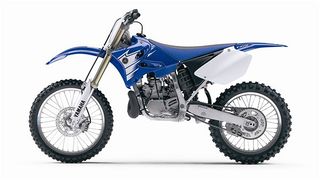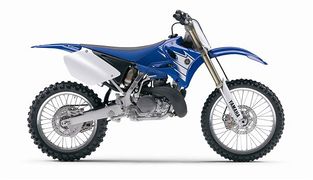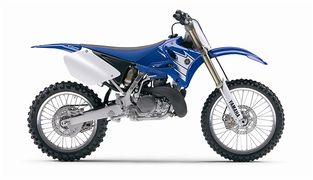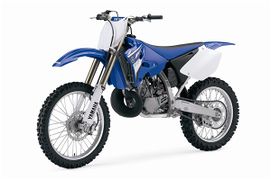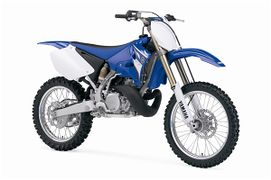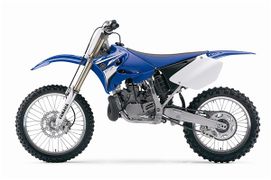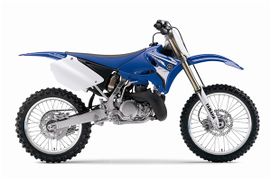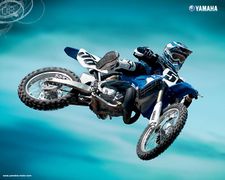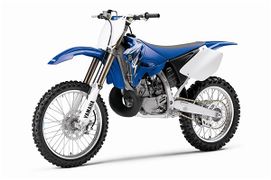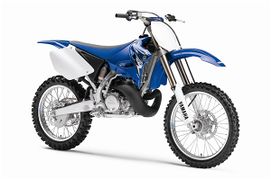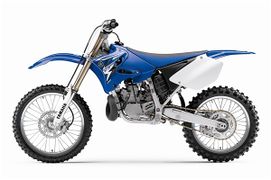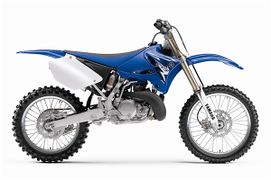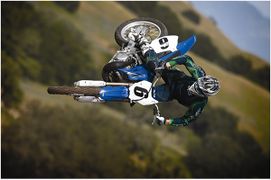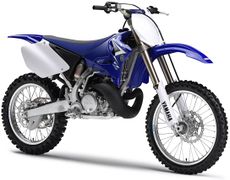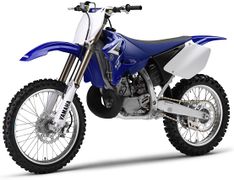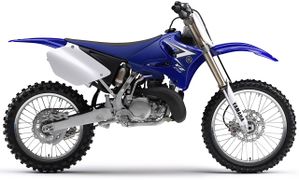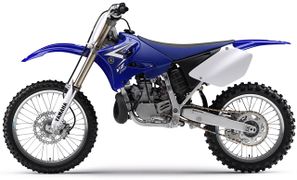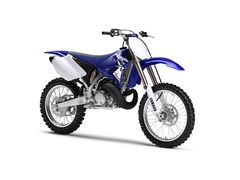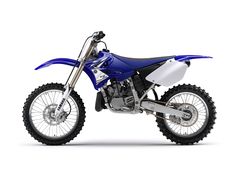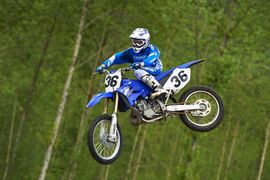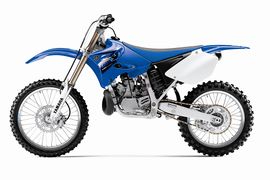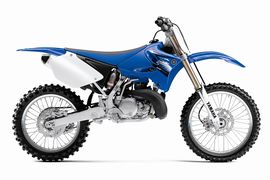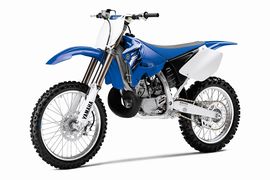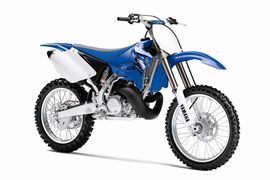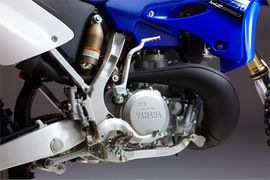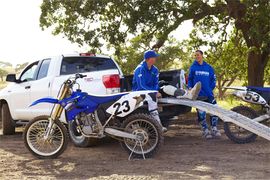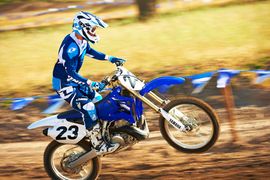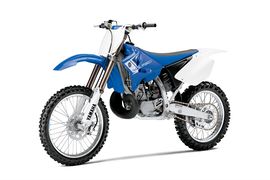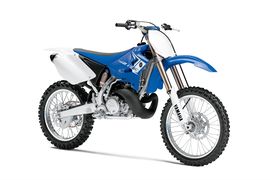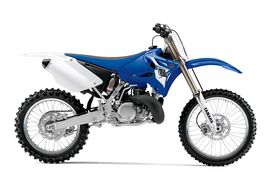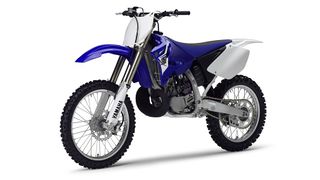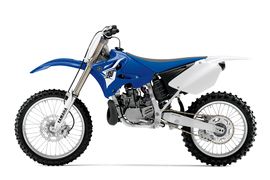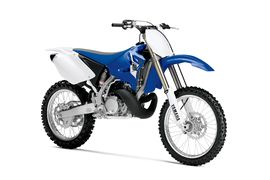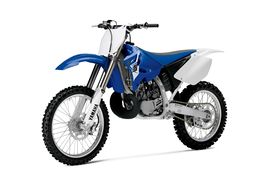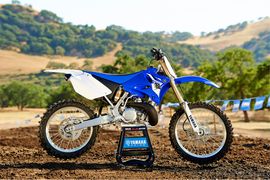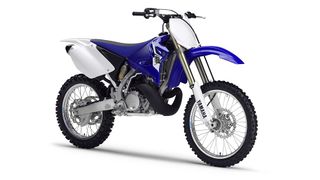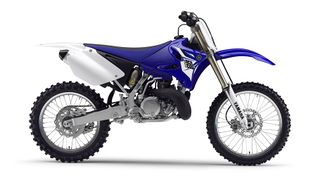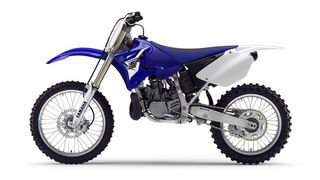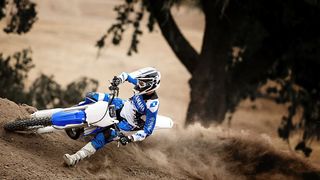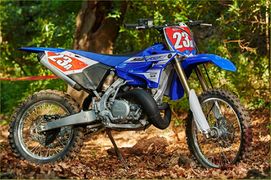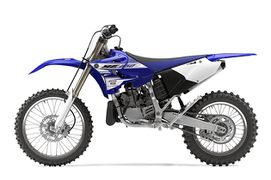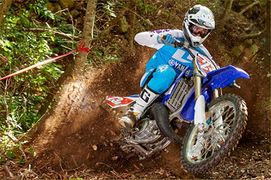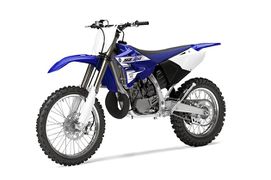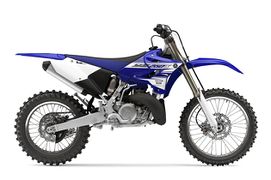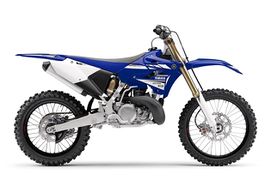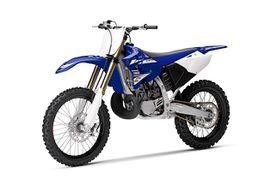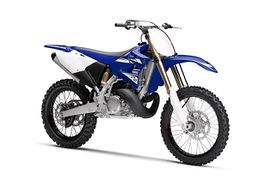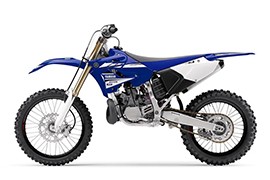Yamaha YZ250: review, history, specs
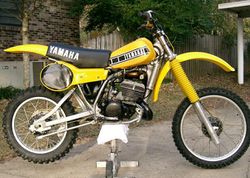 |
|
| Yamaha YZ250 | |
| Manufacturer | |
|---|---|
| Also called | YZ250FSE - Special Edition, YZ250F 60th Anniversay, YZ250X, YZ250FX, YZ250F, YZ 250 F, YZ 250 |
| Production | 1974 - Present |
| Class | Motocross |
| Engine | single cylinder, two-stroke |
| Top Speed | 85 mph |
| Horsepower | 50hp |
| Torque | 32 ft/lbs |
| Ignition | cdi |
| Spark Plug | NGK BR8EIX '98-06 NGK BR8EG '83 , '96-97 NGK B9EV '74-81 NGK B9EG '82 , '84-87 NGK B8EG '88-95 |
| Transmission | Gear box: 5-speed Final Drive: chain |
| Suspension | Front: kyb® spring-type fork with speed sensitive damping; fully adjustable Rear: kyb® single shock; full adjustable |
| Brakes | Front: single disc. hydraulic. Rear: single disc. hydraulic. |
| Front Tire | 3.00-21 '74-75 , '76 , '77-79 , '80 , '81 , '82 90/90-21 '83 , '84 , '85-86 , '87 80/100-21 '88 , '89-93 , '94-95 , '96-97 , '98-02 , '03-06 |
| Rear Tire | 100/90-19 '89-93 110/100-18 '87 , '88 110/90-19 '94-95 , '96-97 , '98-02 , '03-06 140/80-18 '83 4.60-18 '76 4.00-18 '74-75 130/80-18 '84 , '85-86 4.50-18 '77-79 6705 '80 , '81 , '82 |
| Wheelbase | 57.72 inches (1466 mm) |
| Length | 85.2 inches (2164 mm) |
| Width | 32.52 inches (826 mm) |
| Height | 50.39 inches (1280 mm) |
| Seat Height | 37.99 inches (965 mm) |
| Weight | 212.08 pounds (96.2 Kg) (dry), 112.9 kg (wet) |
| Oil Capacity | 0.4 Gallon (1.50 Liters) |
| Recommended Oil | Yamalube 10w-40 |
| Fuel Capacity | 2.0 Gallon (7.57 Liters) |
| Related | Yamaha YZ50 Yamaha YZ60 Yamaha YZ80 Yamaha YZ85 Yamaha YZ100 Yamaha YZ125 Yamaha YZ250 Yamaha YZ400 Yamaha YZ465 Yamaha YZ490 |
| Competition | Honda CR250R Kawasaki KX250 Suzuki RM250 |
| Manuals | Service Manual |
The Yamaha YZ250 was a single cylinder, two-stroke motocross motorcycle produced by Yamaha between 1974 to present. It is one of the last two-stroke 250cc bikes still in production. Yamaha produces a four-stroke version made to compete with this version in the YZ400F/YZ426F/YZ450F. The similarly named Yamaha YZ250F is intended to compete with the Yamaha YZ125.
History[edit | edit source]
Yamaha created the very first single-shock, production motocross bike ever. This was the beginning of the Yamaha Monocross machines that changed motocross forever. The YZs of this time were near replicas of "Works Bikes" with their aluminum fuel tanks and light weight, lacking only magnesium engine cases and a few titanium pieces.
Engine[edit | edit source]
The engine was a air cooled, later liquid cooled single cylinder, two-stroke.
Drive[edit | edit source]
The bike has a 5-speed transmission. Power was moderated via the multiplate wet clutch.
Chassis[edit | edit source]
It came with a 90/90-21 front tire and a 110/100-18 rear tire. Stopping was achieved via single disc. hydraulic. in the front and a single disc. hydraulic. in the rear. The front suspension was a kyb® spring-type fork with speed sensitive damping; fully adjustable while the rear was equipped with a kyb® single shock; full adjustable. The YZ250FX was fitted with a 2.0 Gallon (7.57 Liters) fuel tank. The bike weighed just 212.08 pounds (96.2 Kg). The wheelbase was 57.72 inches (1466 mm) long.
First Generation[edit | edit source]
1974 YZ250A[edit | edit source]
In 1972 Hakan Anderson took a YZ250A to the world motocross championship (and finished second to Joel Robert on his RH72 Suzuki).
- SERIAL # 431-000101 - 004104
1975[edit | edit source]
- SERIAL # 483-000101 - 002759
1976[edit | edit source]
- SERIAL # 509-100101 - 103405
1977[edit | edit source]
- SERIAL # 1W3-000101 - 006520
Second Generation[edit | edit source]
1978 YZ250[edit | edit source]
- SERIAL # 2K7-000101 - 009850
1979 YZ250F[edit | edit source]
This model is technically a YZ250F by its letter designation but in this model's case the F signifies the year, not that it is a four-stroke.
- SERIAL # 2X4-000101 - N/A
1980 YZ250G[edit | edit source]
- SERIAL # 3R4-000101 - ON
1981 YZ250H[edit | edit source]
Third Generation[edit | edit source]
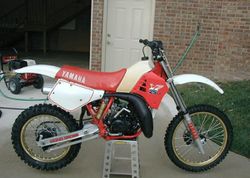 |
|
| Yamaha YZ250 LC | |
| Manufacturer | |
|---|---|
| Production | 1986 - 1993 |
| Class | Motocross |
| Engine | 249cc liquid-cooled single cylinder, two-stroke |
| Bore / Stroke | 68 x 68.8 mm |
| Compression ratio | 9.0 ~ 10.8 : 1 |
| Top Speed | 85 mph |
| Horsepower | 48.8 hp |
| Torque | 32 ft/lbs |
| Ignition | cdi |
| Spark Plug | NGK BR8EG [1] |
| Transmission | Gear box: 5-speed Clutch: multiplate wet clutch |
| Final Drive | Chain: 520x115 [1] |
| Suspension | Front: kyb® spring-type fork with speed sensitive damping; fully adjustable Rear: kyb® single shock; full adjustable |
| Brakes | Front: single disc. hydraulic. Rear: single disc. hydraulic. |
| Front Tire | 90/90-21 '83-87 80/100-21 '88-06 |
| Rear Tire | 100/90-19 '89-93 110/100-18 '87-88 130/80-18 '84 , '85-86 |
| Wheelbase | 57.72 inches (1466 mm) |
| Length | 85.2 inches (2164 mm) |
| Width | 32.52 inches (826 mm) |
| Height | 50.39 inches (1280 mm) |
| Seat Height | 37.99 inches (965 mm) |
| Weight | 104 Kg (229.3 lb) (wet) |
| Oil Capacity | 0.75 L [1] |
| Recommended Oil | Yamahalube 10W-30 |
| Fuel Capacity | 7.7 L (2.03 US gal) [1] |
| Competition | Honda CR250R Kawasaki KX250 Suzuki RM250 |
| Manuals | 1994 Yamaha YZ250 F LC Owners Service Manual More Manuals |
The YZ250 was now liquid-cooled sometimes referred to as YZ250 LC.
1982[edit | edit source]
Came with YPVS Power Valve
1984[edit | edit source]
Improved Monocross suspension, lighter and stronger swing arm, rear shock redesign, larger air box, Z-spokes, redesigned frame and exhaust pipe, lighter and stronger forks. Far more than a warmed over ’83 model, the YZ250L went through a major revamping. Targeted refinements and a huge injection of horsepower made it one of the most competitive bikes of 1984.
1986[edit | edit source]
1990[edit | edit source]
- Red fork legs
1991[edit | edit source]
- new shape sidepanels and rear fender
1992[edit | edit source]
- new front fender
Fourth Generation (1993 - 1995)[edit | edit source]
1993[edit | edit source]
- new plastic design last year using pink, brown/black coating on forks
- 1993 Yamaha YZ250 E LC Owners service manual
1994[edit | edit source]
- purple seat and frame
1995[edit | edit source]
- rear disc cover
Fifth Generation (1996 - 2001)[edit | edit source]
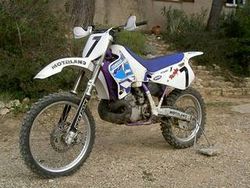 |
|
| Yamaha YZ250 | |
| Production | 1996 - 2001 |
|---|---|
| Top Speed | 85 mph |
| Weight | |
| Recommended Oil | Yamalube 10w-40 |
| Manuals | 1998 Yamaha YZ250 KLC Owners Service Manual 2000 Yamaha YZ250 M LC Owners Service Manual More Manuals |
- 1996 - 1998 redesign and dark blue plastics
- 1999 - up engine redesign, brighter blue plastics but same design
- 2000 - air box white & new front fender
- 2001 - seat cover got black top
Sixth Generation (2002 - 2004)[edit | edit source]
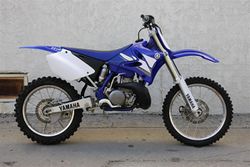 |
|
| Yamaha YZ250 | |
| Production | 2002 -2004 |
|---|---|
| Top Speed | 85 mph |
| Weight | |
| Recommended Oil | Yamalube 10w-40 |
| Manuals | 2002 Yamaha YZ250 (P) LC Owners Service Manual 2003 Yamaha YZ250 R LC Owners Service Manual More Manuals |
2002[edit | edit source]
- 2002 - redesign with frame, swingarm and plastics changed and new kickstarter
2003 Yamaha YZ250[edit | edit source]
There's no F after the 2002 YZ250 so we're dealing with 2-stroke might, this time. This model year received a lot of improvements, starting with a new, lighter and tougher swingarm and recalibrated suspensions, with more precise travel and providing even more control.
In the engine department, the 2002 Yamaha YZ250 comes with a new cylinder head and combustion chamber, a reshaped exhaust port, and a revised second gear for explosive power deployment. The factory-spec racing clutch lever is adjustable, and the rear master cylinder and discs are also revamped.
2004 Yamaha YZ250[edit | edit source]
With around 40 years of YZ250 history, it was natural that the 2003 iteration carried on the acclaimed nerve and maneuverability, in a package with received multiple updates for even higher performance and more durability. The forks went up to 48mm and received a new coating for smoother action, and titanium pegs shaved off some more weight.
The 2003 YZ250 receives a new gripper-style seat cover, revised engine internals for a better mid-range power deployment, and an adjustable clutch lever for quick, on-the-fly fine tuning.
Seventh Generation (2005 - )[edit | edit source]
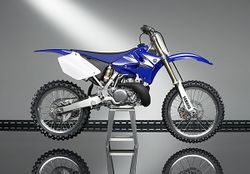 |
|
| Yamaha YZ250 | |
| Production | 2005 - |
|---|---|
| Top Speed | 85 mph |
| Weight | |
| Recommended Oil | Yamalube 10w-40 |
| Manuals | 2005 Yamaha YZ250 Owners Service Manual 2006 Yamaha YZ250 V Owners Service Manual More Manuals |
The main feature of this generation was the switch to an aluminum frame.
2006 Yamaha YZ250[edit | edit source]
Having received an all-new aluminum frame one year before, the 2005 YZ250 got a little more motocross edge thanks to some more tweaking and a new, hydro-formed swingarm. The 48mm fork has also been revised, while the rear suspension got a top-drawer titanium spring, too.
The trim of the 2005 YZ250 includes multiple works-style parts and technologies to allow riders to benefit from the best bang their money can buy. Save for the engine, which is a 2-stroke, the frame is almost identical to that of the 4-stroke machines.
2007 Yamaha YZ250[edit | edit source]
The 2007 MY Yamaha YZ250 got a little more power from its 249cc reed-inducted single, with multiple revisions providing better performance for a lot of components, such as the cylinder, power valve system and carburetor. Quick-access clutch and washable air filter make maintenance easier, reducing the time you'll spend in the garage.
The competition-grade MX aluminum frame keeps the bike light and handling precise, while the speed-sensitive fork adds premium damping and compression characteristics to the ride. Add in Excel rims, Sun Star sprockets, Pro Taper bars and more top-drawer parts to get you past the finish line first.
2008 Yamaha YZ250[edit | edit source]
The 2008 MY YZ250 is the perfect choice of you want to show someone how evil can a quarter-liter 2-stroke machine can be. The machine is infused with the best features of its 4-stroke siblings, and loaded with works-derived technologies, such as a titanium rear shock spring, aluminum frame, a new front rotor and twin piston caliper, Pro taper bars, an adjustable 48mm fork, quick-adjust clutch lever and a redesigned brake lever, as well.
The biggest 2-stroke off-road machine has just gotten better, and this calls for some hard riding, showing your friends who's the boss of the dirt track.
2009 Yamaha YZ250[edit | edit source]
Only those who have ridden a 2-stroke quarter liter off-road machine know the adrenaline rush the amazing power and torque combined with a light weight brings... the rest are about to find out. If real-life racing sensations are one of the things you're looking for, then throwing a leg over the 2009 MY YZ250 is the natural thing to do.
The bike's seat was revised for better support and freedom of movement, while other components have been updated, with lower weight and enhanced performance. The bike also got a new anodized chain for this MY, but new wave rotors in the front and rear are also on the menu, as well as a new, re-valved fork.
2010 Yamaha YZ250[edit | edit source]
A 2-sstroke quarter-liter machine like the 2010 MY YZ250 is a true weapon in the hands of a skilled rider. The engine delivers explosive power as the throttle is twisted and the brawn of this lightweight machine can strike fear in the minds of the faint-hearted. The aluminum frame uses inverted Kayaba forks and a works-derived rear suspension, both adjustable and capable to deliver first-class performance to the discerning rider.
Little has been improved over the previous edition, as it looks like Yamaha's current recipe is a successful one.
2011 Yamaha YZ250[edit | edit source]
The 2011 YZ250 is a competition quarter-liter 2-stroke bike intended for use by well-trained riders. This motorcycle was loaded with premium components derived from the factory racing programs, and is capable to deliver top performance in the hands of a skilled rider. The YZ250 arrives ready to race from the box, equipped with Excel rims, a lightweight aluminum frame, top-drawer adjustable Kayaba suspensions, a titanium rear shock spring, racing-grade sprockets, a repackable silencer and jumbo-sized folding, serrated pegs and foot controls.
2012 Yamaha YZ250[edit | edit source]
This 2-stroke bike sports an aluminum frame and a smooth close-gear 5-speed gearbox. Together with the upright, forward-slanted design, the YZ250 offers unlimited fun for off-road adventure and all the prerequisites for dirt racing at its possible max.
The 2012 MY Yamaha YZ250 is ready to race out of the crate, complete with a ProTaper aluminum handlebar, titanium foot pegs, gripper seat, and Excel rims. Its lightweight build means extremely easy handling, excellent cornering and less fatigue, granting the rider more possibilities to focus on his capabilities, instead of “fighting” the machine.
2013 Yamaha YZ250[edit | edit source]
The 2012 Yamaha YZ250 is ready to race out of the crate, complete with an aluminum handlebar, titanium foot pegs, gripper seat, and Excel rims. Its lightweight build means extremely easy handling, excellent cornering and less fatigue, granting the rider more possibilities to focus on his capabilities, instead of “fighting” the machine.
This 2-stroke bike sports an aluminum frame and a smooth close-gear 5-speed gearbox. Together with the upright, forward-slanted design, the YZ250 offers unlimited fun for off-road adventure and all the prerequisites for dirt racing at its possible max.
2014 Yamaha YZ250[edit | edit source]
The 2013 Yamaha YZ250 carries on the heritage of the bike which won the first-ever World Motocross Championship back in 1973. It retains the 2-stroke principle but the rest of the bike is completely changed, now benefiting from the most advanced technology in the field of MX racing. The chassis is now made in aluminum and rolls with light, cast alloy wheels, USD forks and a Power Valve System for the modern exhaust.
The handling is simply flawless, given the revised suspension settings and chassis sturdiness, while the seat ergonomics have been also updated for good support and maximum freedom of movement.
2016 Yamaha YZ250X[edit | edit source]
Legendary YZ250 249cc liquid-cooled reed-valve-inducted two-stroke engine, a new compression ratio, new exhaust port timing, updated Yamaha Power Valve System (YPVS) timing, and a new model-specific CDI unit – all focused on making a wide, controllable power character ideal for cross-country racing.
2017 Yamaha YZ250[edit | edit source]
The YZ250 with the same engine 250cc liquid-cooled reed-valve-inducted two-stroke engine is lightweight, compact and features an incredibly wide, hard-hitting powerband. New 270mm front disc brake (up from 250mm) also features a new brake pad material for exceptional stopping power and control for aggressive corner entries.
In Movies[edit | edit source]
- La cité rose
- Backlight
- The Death and Life of Bobby Z
- Violetta
- A-X-L
- Creature of Darkness
- Fifth Gear
- CSI: NY
- Charlie's Angels: Full Throttle
- Sand Sharks
- White Gold
- To Be the Best
- Pensacola: Wings of Gold
- Timecop
- Miami Beach Cops
- Honeymoon Academy
- Moonwalker
- Buffy the Vampire Slayer
- Voskresnyy papa
- Outrageous Fortune
- Screamtime
- Top Secret!
- The Devil and Max Devlin
- Les petites fugues
- The Jerk
- P. Diddy feat. Black Rob, Mark Curry: Bad Boy For Life
- S.W.A.T.
- Lie mo zhe
- Man with a Plan
- French Montana feat. Kanye West, Nas: Figure it Out
- Bôsô panikku: Daigekitotsu
- La via della droga
- Die Motorrad-Cops: Hart am Limit
- Flashpoint
- Karla contra los jaguares
- Lian shou jing tan
- The Stray
- Spender
- Winners Take All
- Top Gear USA
- Pawn Stars
- Hawaii Five-0
- Just Add Water
- All Saints
- Barenaked Ladies: One Week
- CHiPs
- Jesus Christ Vampire Hunter
See Also[edit | edit source]
References[edit | edit source]
| ||||||||
| ||||||||
